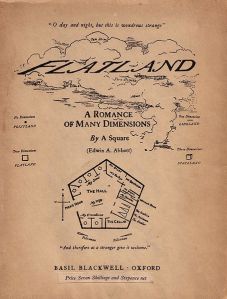Originally posted December, 2013.
I’m working on a paper in which I hope to discuss the particular treatment of women in the dystopian novel W, ou le souvenir d’enfance by Georges Perec (1975). It’s a project I’ve been putting off due to personal hurdles, but one that came back to me recently as I was reading Flatland: A Romance of Many Dimensions (1884) by Edwin Abbott. In both societies, filled with oppression and clearly identified class systems, the women are treated not only differently from the men, but in such a way that reduces them to objects to be won (in the case of W), the source of man’s woe (in Flatland), and (in both worlds) the function of procreation.
Abbott’s short dystopian tale of a square in Flatland first came to my attention about 10 years ago when I was working in a bookstore where I would frequently come across it on the sci-fi/fantasy shelf, always intrigued by the title, but always busy reading something else. I finally decided to read it when it came up as one of the most-read ebooks on the GoodReads app for iPhone. The Square who narrates has tried to share the Theory of Three Dimensions with the people of his two-dimensional world, only to find himself imprisoned for life because of this theory. He is lucky, however that he isn’t a lowly triangle, especially an isosceles, or he would have been put swiftly to death. Squares are not nearly the most powerful people in Flatland, however. Each generation in the various classes – from equilateral triangles, to squares, to pentagons and upward – increases in number of sides by one. Eventually a child is born with so many sides that he is virtually indistinguishable from a circle, and thus he is the highest form – a priest.
But notice that this elevation from three-sided figure to the powerful circles that run Flatland only occurs in male children. Women are always a single line, a form that is problematic since women are essentially walking weapons; a line from a certain angle is simply a long, sharp point. When women accidentally backup into another person, the other is usually destroyed, and the women is often destroyed as well, if she cannot remove herself quickly enough from the run-through victim. Women also receive no education, having been long ago judged as too unintelligent to grasp the important skills that men learn in Flatland, so that through the generations, uneducated girls have become ignorant women with short memories who mostly serve to frustrate their husbands.
In the completely fictional part of the W, ou le souvenir d’enfance (it’s a complex postmodern and oulipian work interweaving memories, real and fictional, of a Jewish boy during the Second World War, and a story written by that boy when he was child), all but the powerful men at the top of society are completely mistreated through violence and mental manipulation. The men compete in Olympic-style competitions that result in their feasting for one night afterward, but which also have arbitrary rules that de-humanize the athletes and change without warning to unsettle the competition and amuse the men in charge. One of the highest honors is to run against other athletes in front of a crowd in pursuit of naked women. This level of competition often results in violence between male competitors, as well as against the women–who are raped on the field in front of the crowd as the prize to those who catch them first.
In dystopian worlds, the majority of people face the harsh realities of a shitty life, but the ones who have it hard in our “real” world are the ones whose lives are the shittiest of all. Women just happen to be a group that is discussed in these stories, but I’m sure in the back of the authors’ minds, there were all kind of horrible possibilities for the non-white, non-Western, non-hetero, non-rich, non-“able-bodied” among these dystopian societies. Or in the case of Flatland, the non-geometrical, non-hetero, etc. Nonetheless, interesting dystopian tales with seemingly clear critiques of the hierarchy of our society.

